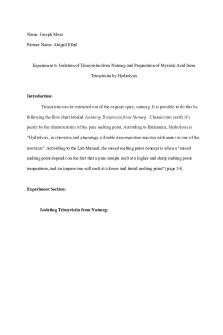Post Lab Report Lab 5 PDF

| Title | Post Lab Report Lab 5 |
|---|---|
| Course | Organic Chemistry Laboratory I |
| Institution | University of South Florida |
| Pages | 5 |
| File Size | 265.3 KB |
| File Type | |
| Total Downloads | 58 |
| Total Views | 168 |
Summary
This is the post-lab report for Lab 6....
Description
Name: Joseph Mesa Partner Name: Abigail Efird
Experiment 6: Isolation of Trimyristin from Nutmeg and Preparation of Myristic Acid from Trimyristin by Hydrolysis
Introduction: Trimyristin can be extracted out of the organic spice, nutmeg. It is possible to do this by following the flow chart labeled Isolating Trimyristin from Nutmeg. Chemist can verify it’s purity by the characteristics of the pure melting point. According to Britannica, Hydrolysis is “Hydrolysis, in chemistry and physiology, a double decomposition reaction with water as one of the reactants”. According to the Lab Manual, the mixed melting point concept is when a “mixed melting point depends on the fact that a pure sample melt at a higher and sharp melting point temperature, and an impure one will melt at a lower and broad melting point” (page 34).
Experiment Section:
Isolating Trimyristin from Nutmeg:
Preparing Myristic Acid from Trimyristin by Hydrolysis:
Table of Chemicals:
Trimyristin: may be irritating to the mucous membranes and respiratory tract. a A white too yellowish - grey solid.
Myristic Acid: causes eye, skin, gastrointestinal irritation, and respiratory tract irritation. it It looks like white crystals or powder.
This is a Base Hydrolysis of an ester group.
This is the overall reaction of the second part of the experiment.
Results:
Mass of Nutmeg Mass of 25 mL Vacuum Flask Empty Mass of 25 mL Vacuum Flask with Trimyristin Mass of Crude Trimyristin Mass of Pure Trimyristin Percent Recovery
1.99 g 35.18 g 35.70 g 0.52 g 0.14 g 7.04% 44.1-
Crude Trimyristin m.p 47.3°C 56.4Pure Trimyristin m.p Trimyristin weighed Myristic Acid Crude weighed Myristic Acid Pure weighed Percent Yield Mystric Acid Pure Myristic Acid m.p
65.8°C 0.2 g 0.67 g 0.42 g 62.70% 51.8-66°C 60.8-
50/50 Myristic Acid and Trimystristin m.p 69.5°C Crude Myristic Acid m.p 57.6-66°C
How to Calculate: (Mass of Pure Percent Recovery of
trimyristin/Mass of
Trimyristin
nutmeg) x 100 (Mass of Pure Myristic Acid /Mass
Percent Yield of of crude mystic Myristic Acid acid) x 100
Discussion:
Overall the experiment wasn’t efficient from the beginning considering that trimyristin is only found in 25-40% in nutmeg. Our percent recovery of trimyristin is only 7.04%. Our percent yield of Myristic acid is only 62.70%, which is more efficient than the extraction of trimyristin but overall not efficient. This could also be due to the water leakage of our condenser set up, but we still don’t know how much damage the mishap caused. Conclusion: During this experiment, we anticipated a very low yield however our yield was much lower than expected. If trimyristin consist of 25-40% of nutmeg’s mass, then that’s how much yield should be expected. 7.04% percent recovered is much lower than expected. This reveals that this experiment is not efficient. According to SciencDirect, “Solvent extraction appears to have great potential in the field of effluent treatment, both for the economical recovery of valuable materials and for their removal to comply with statutory requirements” and this is one of many reason why extracting chemicals out of organic compounds is applicable to scientist around the world. We did, however, accomplished the objective, which was to isolate trimyristin from nutmeg and synthesize the product into myristic acid and purify the crude through recrystallization.
References:
“Hydrolysis.” Encyclopædia Britannica, Encyclopædia Britannica, Inc., https://www.britannica.com/science/hydrolysis. “Solvent Extraction.” Solvent Extraction - an Overview | ScienceDirect Topics, https://www.sciencedirect.com/topics/earth-and-planetary-sciences/solvent-extraction....
Similar Free PDFs

Post Lab Report Lab 5
- 5 Pages

Post Lab - lab report
- 2 Pages

Lab 5 Post-Lab Assignment
- 3 Pages

Post Lab Report 7
- 8 Pages

Post Lab Report 10
- 8 Pages

LAB 5 - Lab report
- 4 Pages

Post lab report 4
- 12 Pages

Lab Report 5 - lab
- 5 Pages

Lab 5 - Lab report
- 6 Pages

Post-Lab 5 - assignments
- 3 Pages

Experiment 5 Post Lab
- 5 Pages

Post lab - Post Lab 1
- 2 Pages

LAB Report 2 - Post Lab Question
- 2 Pages
Popular Institutions
- Tinajero National High School - Annex
- Politeknik Caltex Riau
- Yokohama City University
- SGT University
- University of Al-Qadisiyah
- Divine Word College of Vigan
- Techniek College Rotterdam
- Universidade de Santiago
- Universiti Teknologi MARA Cawangan Johor Kampus Pasir Gudang
- Poltekkes Kemenkes Yogyakarta
- Baguio City National High School
- Colegio san marcos
- preparatoria uno
- Centro de Bachillerato Tecnológico Industrial y de Servicios No. 107
- Dalian Maritime University
- Quang Trung Secondary School
- Colegio Tecnológico en Informática
- Corporación Regional de Educación Superior
- Grupo CEDVA
- Dar Al Uloom University
- Centro de Estudios Preuniversitarios de la Universidad Nacional de Ingeniería
- 上智大学
- Aakash International School, Nuna Majara
- San Felipe Neri Catholic School
- Kang Chiao International School - New Taipei City
- Misamis Occidental National High School
- Institución Educativa Escuela Normal Juan Ladrilleros
- Kolehiyo ng Pantukan
- Batanes State College
- Instituto Continental
- Sekolah Menengah Kejuruan Kesehatan Kaltara (Tarakan)
- Colegio de La Inmaculada Concepcion - Cebu


